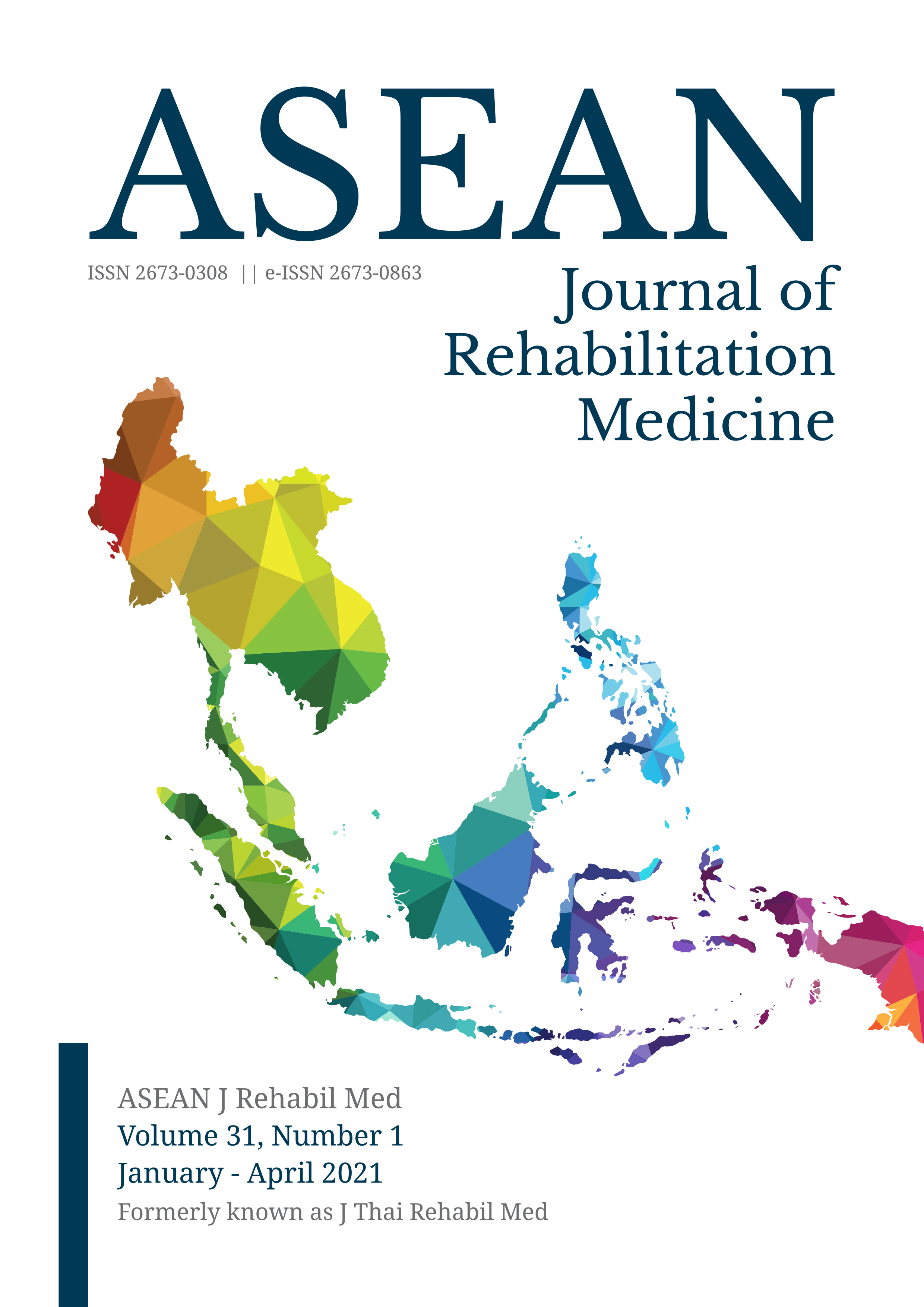Use of Robotic Gait Training in Hyperglycaemia-Induced Central Pontine Myelinolysis: A Case Report
Keywords:
myelinolysis, central pontine, robotics, gait disorders, rehabilitationAbstract
Objectives: To describe a rarely-seen cause of central pontine myelinolysis (CPM), and the benefits of application of robot-assisted gait retraining (RAGT) in a model of impairment-directed rehabilitation in the management of gait ataxia.
Study design: Case report.
Setting: Inpatient rehabilitation unit of tertiary hospital, Singapore.
Subjects: A 69-year-old male who presented with giddiness, cognitive impairment, and gait ataxia.
Methods: The patient underwent magnetic resonance imaging of the brain which revealed pontine hyper-intensity suggestive of CPM. His diagnostic work-up revealed significant hyperglycaemia.
Results: He underwent treatment for his metabolic derangements and was referred for rehabilitation. We added robot-assisted gait training in the treatment of his ataxia. He was able to ambulate independently subsequently and was discharged uneventfully.
Conclusion: CPM is an uncommon but disabling condition typically seen in rapid correction of hyponatraemia. In our patient this was caused by hyperglycaemia, which likely drives the same osmotic derangements that leads to the dramatic impairments that characterise this condition. Rehabilitation of hyperglycaemia-induced CPM has yet to be described but the condition is becoming more frequently recognised in clinical practice. In addition, given the benefits of RAGT in gait ataxia, there is great potential in the role that RAGT can play in the exploration of best practices beyond CPM in a model of impairment-directed therapy in future.
Keywords: myelinolysis, central pontine, robotics, gait disorders, rehabilitation
References
Singh TD, Fugate JE, Rabinstein AA. Central pontine and extrapontine myelinolysis: a systematic review. Eur J Neurol. 2014;21:1443-50.
Saini M, Mamauag MJ, Singh R. Central pontine myelinolysis: a rare presentation secondary to hyperglycaemia. Singapore Med J. 2015;56:e71-3.
Talluri S, Charumathi R, Khan M, Kissell K. Atypical presentation of central pontine myelinolysis in hyperglycemia. Endocrinol Diabetes Metab Case Rep. 2017;2017:17-0064. doi: 10.1530/EDM-17-0064.
Burns JD, Kosa SC, Wijdicks EFM. Central pontine myelinolysis in a patient with hyperosmolar hyperglycemia and consistently normal serum sodium. Neurocrit Care. 2009;11:251-4.
O’Malley G, Moran C, Draman MS, King T, et al. Central pontine myelinolysis complicating treatment of the hyperglycaemic hyperosmolar state. Ann Clin Biochem. 2008;45:440-3.
Fuller K, Guerrero C, Kyin M, Timple C, Yeseta M. The role of the interdisciplinary team in subacute rehabilitation for central pontine myelino-lysis. Disabil Rehabil. 2020;42:3112-8.
Bultmann U, Pierscianek D, Gizewski ER, Schoch B, Fritsche N, Timmann D, et al. Functional recovery and rehabilitation of postural impairment and gait ataxia in patients with acute cerebellar stroke. Gait Posture. 2014;39:563-9.
Mehrholz J, Thomas S, Werner C, Kugler J, Pohl M, Elsner B. Electromechanical-assisted training for walking after stroke. Cochrane Database Syst Rev. 2017. doi: 10.1002/ 14651858.CD006185.pub4.
Tay SS, Neo JRE, Tan MJM, Tan PL. Post-critical care COVID-19 patient benefits from a robotic patient-guided suspension system for pulmonary rehabilitation. Ann Acad Med Singapore. 2020;49:401-4.
Esquenazi A, Talaty M. Robotics for lower limb rehabilitation. Phys Med Rehabil Clin N Am. 2019;30:385-97.
Marks D, Schweinfuther R, Dewor A, Huster T, Paredes LP, Zutter D, et al. The Andago for overground gait training in patients with gait disorders after stroke - results from a usability study. Physiother Res Rep. 2019;2:1-8.
Downloads
Published
How to Cite
Issue
Section
License
Copyright (c) 2021 ASEAN Journal of Rehabilitation Medicine

This work is licensed under a Creative Commons Attribution-NonCommercial-NoDerivatives 4.0 International License.






